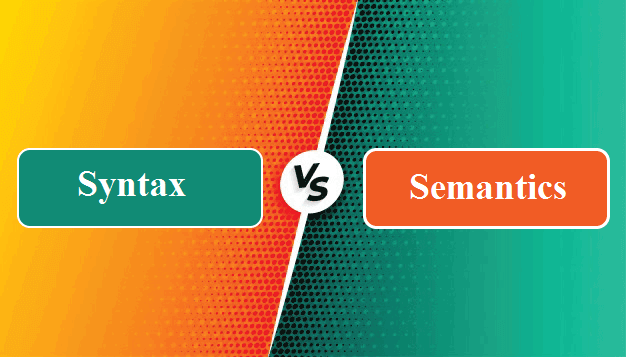Difference between Syntax and SemanticsSyntax and semantics are important terms in any computer programming language. In a programming language, syntax refers to the collection of a language's allowable words; in contrast, semantics expresses the associated meaning of those words. There are several syntactic and semantic linkages in which each semantic element is connected to at least one syntactic rendition. The other ensures that each syntactic representation has a separate meaning. In this article, you will learn about the difference between Syntax and Semantics. But before discussing the differences, you must know about Syntax and Semantics. What is Syntax?The syntax of computer programming language is utilized to represent the structure of programs without viewing their meaning. It mainly focuses on the structure and arrangement of a program with the help of its appearance. It consists of a set of rules and regulations that validates the sequence of symbols and statements that are utilized in a program. Both human languages and programming languages rely on syntax, and the pragmatic and computation model represents these syntactic elements of a computer programming language. Use of grammar in SyntaxUsually, grammar is rewriting rules whose aim is to recognize and make programs. Grammar doesn't rely on the computation model but rather on the description of the language's structure. The grammar includes a finite number of grammatical categories (including noun phrases, articles, nouns, verb phrases, etc.), single words (alphabet elements), and well-formed rules that govern the order in which the grammatical categories may appear. Techniques of SyntaxThere are several formal and informal techniques that may help to understand the syntax of computer programming language. Some of those techniques are as follows: 1. Lexical Syntax It is utilized to define basic symbols' rules, including identifiers, punctuators, literals, and operators. 2. Concrete Syntax It describes the real representation of programs utilizing lexical symbols such as their alphabet. 3. Abstract Syntax It communicates only the essential program information. Types of GrammarsThere are several types of grammar utilized in the programming syntax. Some of those are as follows: 1. Context-free Grammar It is commonly utilized to determine the overall structure of a language. 2. Regular Expressions It explains a programming language's lexical units (tokens). 3. Attribute Grammars It defines the language's context-sensitive parts. What is Syntax Highlighting?The syntax elements of a programming language (variable names, keywords, operators, etc.) are colored in a text editor or IDE that supports syntax highlighting, making the code easier to understand. How do you prevent a syntax error?Syntax errors occur when a command is typed incorrectly in a command line or when a bug is discovered in a program or script. The command or code should be written without any syntax errors to avoid syntax errors. What are Semantics?Semantics is a linguistic concept that differs from syntax. In a computer programming language, the term semantics is utilized to determine the link between the model of computation and the syntax. The concept behind semantics is that linguistic representations or symbols enable logical outcomes because a collection of words and phrases communicates ideas to machines and humans. The syntax-directed semantics approach is utilized to map syntactical concepts to the computational model via a function. Techniques of SemanticsThere are several techniques that may help to understand the semantics of computer programming language. Some of those techniques are as follows: 1. Algebraic semantics It analyzes the program by specifying algebra. 2. Operational Semantics After comparing the languages to the abstract machine, it evaluates the program as a series of state transitions. 3. Translational Semantics It mainly concentrates on the methods that are utilized for translating a program into another computer language. 4. Axiomatic Semantics It specifies the meaning of a program by developing statements about an establishment that detain at every stage of the program's execution. 5. Denotational Semantics It represents the meaning of the program by a set of functions that work on the program state. Types of SemanticsThere are several types of semantics. Some of those are as follows: 1. Formal Semantics Words and meanings are analyzed philosophically or mathematically in formal semantics. It constructs models to help define the truth behind words instead of considering only real-world instances. 2. Lexical Semantics It is the most well-known sort of semantics. It searches for the meaning of single words by taking into consideration the context and text surrounding them. 3. Conceptual Semantics The dictionary definition of the word is analyzed before any context is applied in conceptual semantics. After examination of the definition, the context is explored by searching for linking terms, how meaning is assigned, and how meaning may change over time. It can be referred to as a sign that the word conveys context. Key differences between Syntax and Semantics
There are various key differences between Syntax and Semantics. Some of the key differences between Syntax and Semantics are as follows:
Head-to-head comparison between Syntax and SemanticsHere, you will learn head-to-head comparisons between Syntax and Semantics. The main differences between Syntax and Semantics are as follows:
ConclusionA programming language's syntax is a group of rules that control the structure or form of code. In contrast, semantics is the interpretation of the code or the associated sense of symbols, letters, or any other aspect of a program.
Next TopicDifference between
|
 For Videos Join Our Youtube Channel: Join Now
For Videos Join Our Youtube Channel: Join Now
Feedback
- Send your Feedback to [email protected]
Help Others, Please Share










